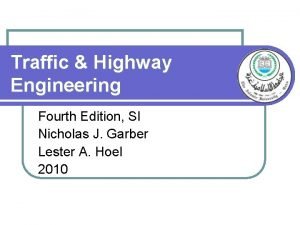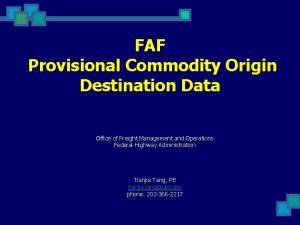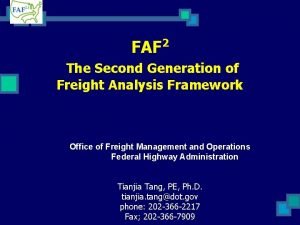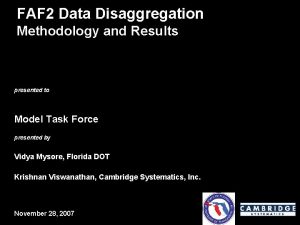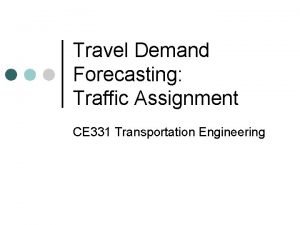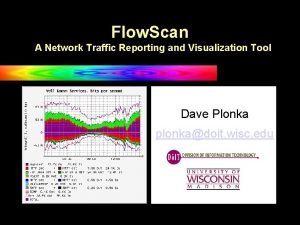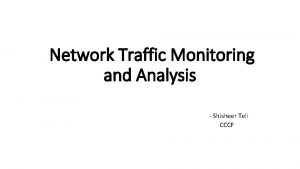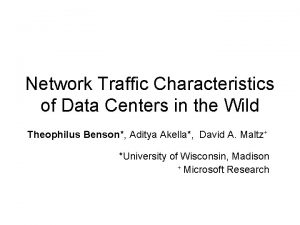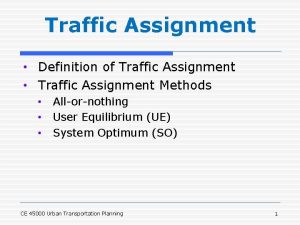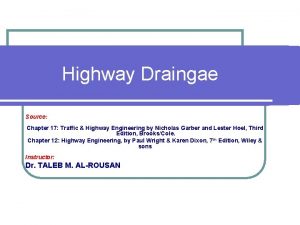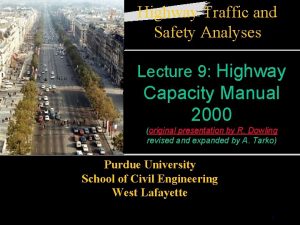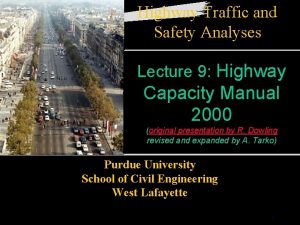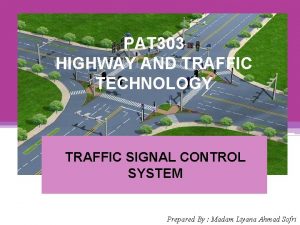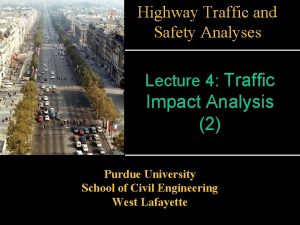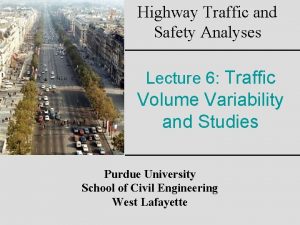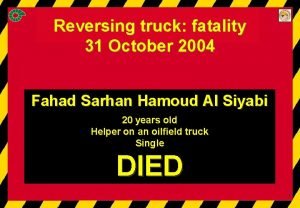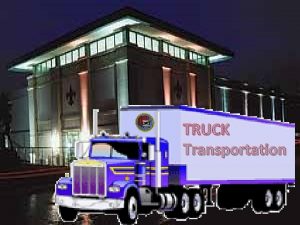Network Assignment of Highway Truck Traffic in FAF














- Slides: 14

Network Assignment of Highway Truck Traffic in FAF 3 Maks Alam, PE Research Leader Battelle BUSINESS SENSITIVE 1

Task Flow Task #1 Update the FAF Network Link Attributes Data Task 3 Truck Trips, Payload and PCE Factors Task 2 Deliverable #1 Pre-Assign non-FAF Traffic Counts FAF 3 Network Task 4 FAF 3 Assignments Task 5 Deliverable #2 FAF 3 Network with 2007 Assignments Deliverable #3 FAF 3 Forecast Year Assignments FAF 3 Network with 2040 Forecast Assignments Task 6 Deliverable #4 Documentation Technical Report BUSINESS SENSITIVE 2

Process Description Task 1: Update FAF 3 Highway Network • Updating of the FAF 3 network for NHS, Intermodal connectors, and urban by-pass other State specific sources for major highway realignment. • Integration and updating of NN designation, NHS designation changes (up to-date March 2010), LCV network designation, state truck and hazmat route designation, state truck route restriction, limited bridge clearance Task 2: Pre-Assigning non-FAF Traffic Counts to the FAF 3 Network • Integrate HPMS 2008 data with FAF 3 network using a series of state specific route matching algorithms customized for each State. • Develop algorithms to translate the HPMS traffic-flow information to the FAF network domain • Calibrate state traffic flows and truck percentage at the state and urban boundaries Task 3: Truck Trips, Payload and Passenger Car Equivalency Factors • Revise FAF-2 algorithms and factors using the TEP project completed for FHWA in 2009. • Update the conversion tools developed by Battelle during FAF-2 to reflect the new changes in FAF-3 zone and gateways system and the range of operation by truck classes • Develop Truck based O-D matrix using the TEP and allocation of tonnage by truck classes. BUSINESS SENSITIVE 3

Process Description Task 4: Assignment of FAF 3 Flows to the Highway Network • Develop and update FAF-2 link specific Impedance factors • Develop and identify disaggregation network specific nodes to develop 123 by 123 OD matrix to 4609 by 4609 O-D matrix • Develop disaggregation factors for domestic and international movements. • Use Trans. CAD SUE traffic assignment with passenger volume as preloaded volume on the network • Calibrate flow by adjusting initial link impedance, alpha, beta values, and disaggregation factors • Use BPR delay functions • Multiple trial and error iteration until FAF truck flows is comparable with the state truck flows develop in task 2 • Compare HPMS truck VMT with the FAF truck VMT for the base year 2007 BUSINESS SENSITIVE 4

FAF Tonnages to Truck Conversion steps Calibrate mean payloads (e. g. VTRIS weight data) Identify vehicle groups Select major body types 10/21/2021 Calculate mean payloads by vehicle group and body type Analyze Regional variability Calculate TEF -National -Regional Calculate percent distribution by vehicle group and body type BUSINESS SENSITIVE 5

Vehicle Groups 1. Straight trucks 2. Straight truck plus trailer 3. Tractor plus trailer 4. Tractor plus double trailers 5. Tractor plus triple trailers 10/21/2021 BUSINESS SENSITIVE 6 6

Major Body Types • Dry Van • Logging (2. 1%) • Platform (24. 4%) • Livestock • Bulk • Automobile • Reefer • Other (37. 7%) (14. 7%) (8. 2%) (1. 7%) (0. 9%) (2. 3%) • Tank (7. 9%) 10/21/2021 BUSINESS SENSITIVE 7

Conversion Algorithms • Xi tons of commodity i carried by truck type Yj and body type k = Xi βijk • Number of truck type Yj and body type k to move Xi βijk tons commodity i = Xi βijk / ωijk βijk = fraction of commodity i moved by truck type j with body type k ωijk = mean payload of commodity i by truck type j body type k 10/21/2021 BUSINESS SENSITIVE 8 8

Conversion Algorithms Continue 10/21/2021 FAF 3: Task 3 Truck Trips, BUSINESS SENSITIVE 9 9

FAF-3 Freight Travel Demand Model FAF 3 O-D (123 by 123 zones) Step 1 Disaggregation Techniques Develop O-D Share Proportioning -Truck Volume - CBP -warehouse cluster Domestic International Logistical Impacts Trip Distribution Model Validity Test Inflow/Outflow County-to-County FAF 2 O-D Matrix Impedance Function Calibration (Use FAF-2 base TLD) Step 3 FAF 3 Network Assignment (SUE) Tri-Proportional Gravity Model Gamma (combined) Function Step 2 Disaggregate by Domestic, Port and Border Crossings BUSINESS SENSITIVE The dotted loop portion of the figure indicates that the process is iterative until a best possible solution is accomplished BUSINESS SENSITIVE 10

Border Crossings Trip O-D nodes BUSINESS SENSITIVE 11

Inlands and Deep Water Trip O-D nodes BUSINESS SENSITIVE 12

FAF-3 Truck Trip O-D nodes BUSINESS SENSITIVE 13

Domestic Flow (Preliminary) BUSINESS SENSITIVE 14
 Traffic and highway engineering 4th edition
Traffic and highway engineering 4th edition Faf data
Faf data Faf 2
Faf 2 Pal değeri hesaplama
Pal değeri hesaplama Faf data
Faf data Faf aff
Faf aff Inbound traffic vs outbound traffic
Inbound traffic vs outbound traffic All traffic solutions
All traffic solutions Dynamic traffic assignment
Dynamic traffic assignment Network flow visualization tool
Network flow visualization tool Network traffic management techniques
Network traffic management techniques Network traffic monitoring techniques
Network traffic monitoring techniques Understanding data center traffic characteristics
Understanding data center traffic characteristics Flowmon traffic recorder
Flowmon traffic recorder Network traffic alpha sky net
Network traffic alpha sky net
